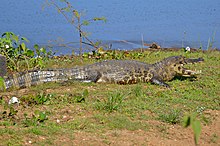Yacare caiman
| Yacare caiman | |
|---|---|

| |
| Mato Grosso, Brazil | |
| Scientific classification | |
| Domain: | Eukaryota |
| Kingdom: | Animalia |
| Phylum: | Chordata |
| Class: | Reptilia |
| Clade: | Archosauromorpha |
| Clade: | Archosauriformes |
| Order: | Crocodilia |
| Family: | Alligatoridae |
| Genus: | Caiman |
| Species: | C. yacare
|
| Binomial name | |
| Caiman yacare Daudin, 1802
| |

| |
| Range (green) | |
The yacare caiman (Caiman yacare, jacaré in Portuguese) is a species of caiman found in central South America, including northeastern Argentina, Uruguay, southeastern Peru, eastern Bolivia, central/southwest Brazil, and the rivers of Paraguay. About 10 million individual yacare caimans exist within the Brazilian pantanal, representing what is quite possibly the largest single crocodilian population on Earth.
Description
As a small and medium-sized crocodilian, most adult males grow to roughly 2 or 2.5 m (6.6 or 8.2 ft) in length, with the occasional 3 m (9.8 ft) individual. Females are much smaller, at an average of 1.4 m (4.6 ft). Body mass in this species can range up to 58 kg (128 lb) in males and from 14 to 23 kg (31 to 51 lb) in females.[2] Their relatively smaller size makes them a potential prey of the jaguar[3] and anaconda.[4]
This species' diet consists primarily of fish (especially piranha) as well as birds, reptiles and small mammals. Occasional large mammals (especially capybara) are taken by larger adults. In general, due to their size, this species is not considered to pose a serious danger to humans.
Gallery
References
- ^ Crocodile Specialist Group (1996). "Caiman yacare". The IUCN Red List of Threatened Species. 1996. IUCN: e.T46586A11062609. doi:10.2305/IUCN.UK.1996.RLTS.T46586A11062609.en. Retrieved 9 November 2017.
- ^ 3.3 Caimans
- ^ http://www.huffingtonpost.com/2013/09/27/jaguar-attacks-crocodile-caiman-video_n_4004616.html
- ^ http://www.discoveryuk.com/web/swimming-with-monsters/about/anaconda-facts/








